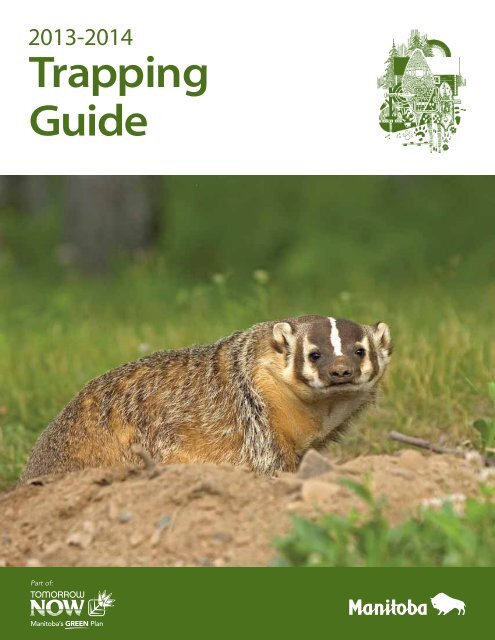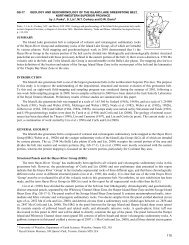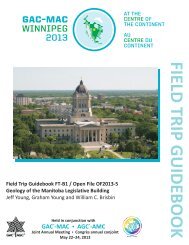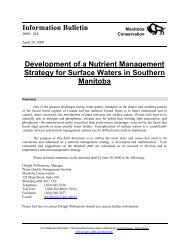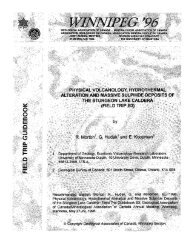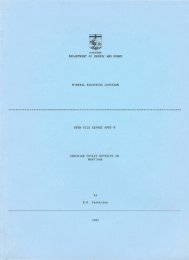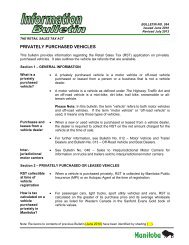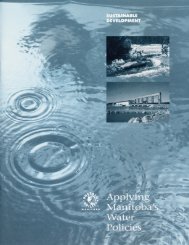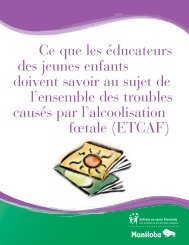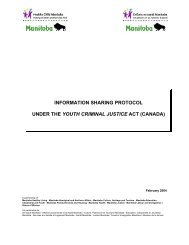Trapping Guide - Government of Manitoba
Trapping Guide - Government of Manitoba
Trapping Guide - Government of Manitoba
You also want an ePaper? Increase the reach of your titles
YUMPU automatically turns print PDFs into web optimized ePapers that Google loves.
2013-2014<strong>Trapping</strong><strong>Guide</strong>
TRAPPING GUIDEFURBEARERS TAKEN BY MANITOBA TRAPPERS5 year Harvest averages Annual total1996/97-2000/01 2001/02-2005/06 2006/07-2010/11 2011/12 2012/13*Badger 135 159 147 201 125Bear 38 58 33 25 n/aBeaver 27,410 21,055 8,175 14,716 6,104Bobcat n/a 17 9 36 10Coyote 2,691 7,460 4,748 11,310 5,627Fisher 1,854 1,807 1,508 2,071 1,066Fox - Red/Cross/Silver 2,006 2,360 1,865 3,232 2,045Fox - White/Blue 380 182 34 160 28Lynx 239 902 696 785 521Marten 21,276 19,200 16,846 22,922 21,186Mink 6,044 3,931 1,672 2,321 2,444Muskrat 63,225 20,162 25,232 57,349 10,847Otter 1,900 2,331 986 1,304 800Raccoon 2,420 2,845 2,723 3,677 799Squirrel 8,620 4,570 1,404 4,270 1,743Weasel (long- & short-tailed) 2,562 3,081 1,434 4,358 2,703Wolf 241 301 165 427 195Wolverine 43 40 42 69 47* to May 2013AVERAGE PELT VALUES ($) OF MANITOBA FURBEARERS5 year averages Annual averages1996/97-2000/01 2001/02-2005/06 2006/07-2010/11 2011/12 2012/13Badger 23.04 42.21 43.07 42.31 43.19Bear 104.71 89.63 85.67 108.24 97.26Beaver 30.85 24.18 20.30 30.40 30.26Bobcat n/a 148.75 126.32 221.56 209.70Coyote 33.91 40.98 31.94 55.58 82.41Fisher 44.29 37.98 59.48 93.01 154.50Fox – Red 22.82 29.03 23.26 41.60 65.76Fox – White 23.76 22.22 21.39 55.80 70.60Lynx 84.51 133.94 130.37 136.83 194.99Marten 47.42 50.79 59.97 91.86 148.63Mink 22.26 18.25 16.20 23.84 34.07Muskrat 3.47 2.68 4.15 7.71 11.65Otter 72.99 142.94 44.86 100.49 115.29Raccoon 18.05 16.31 15.48 15.85 27.63Squirrel 1.24 1.09 1.15 0.66 0.85Ermine 3.44 3.84 4.30 3.19 2.86Wolf 115.16 110.46 147.23 112.74 112.98Wolverine 233.87 216.04 233.19 247.50 280.96ROYALTY - TOTAL COLLECTED2008/09 2009/10 2010/11 2011/12 2012/13*$43,651 $32,840 $33,916 $52,221 $34,847* as <strong>of</strong> June 201313
TRAPPING GUIDERights-based harvestersThe Rights and Responsibilities <strong>of</strong> First Nations PeopleWho Trap in <strong>Manitoba</strong>The Natural Resources Transfer Agreement (1930), which forms part <strong>of</strong>The Constitution Act (1982), provides that First Nations people havethe right to trap for food:• at all seasons <strong>of</strong> the year on all unoccupied Crown lands• on any other lands to which they may have the right <strong>of</strong> accessRecognizing the Treaty and Constitutional rights <strong>of</strong> First Nationspeople, <strong>Manitoba</strong> Conservation and Water Stewardship recognizesthat status Indian people, when trapping for food or traditionalceremonial purposes on lands where they have a right <strong>of</strong> access:• do not require licences• are not restricted to specific seasons• are not restricted to limits unless there restrictions that areintended for conservation purposes• may share the meat and fur with non-status family membersliving in the same residence• are not subject to equipment restrictions including those asspecified under EU Regulation #3254/91 or more commonlyknown as the Agreement on International Humane <strong>Trapping</strong>StandardsFirst Nations people generally have the right <strong>of</strong> access to trapfor food or traditional ceremonial purposes within:• Indian Reserves, Wildlife Management Areas, Provincial Forests,areas <strong>of</strong> Provincial Parks where licensed trapping is permitted,unoccupied Crown lands, and other Crown lands where licensedhunting or trapping is permitted• private land with the permission <strong>of</strong> the landowner or occupant• federal land, such as PFRA community pastures are opened tothe public for trapping, or with the permission <strong>of</strong> the PastureManagerNo person (status or non-status) may trap within:• Riding Mountain National Park, Birds Hill Provincial Park,Beaudry Provincial Heritage Park or Pembina Valley ProvincialPark• areas <strong>of</strong> Provincial Parks closed to all hunting or trapping• Wildlife Refuges and most Ecological Reserves• areas closed to all persons for specific conservation purposesResponsibilitiesWith these rights come responsibilities such as conservation andsafety requirements. All First Nations trappers have a responsibilityto ensure that their actions in taking furbearers do not reduce thesustainability <strong>of</strong> furbearer populations.The rights <strong>of</strong> status Indian people are subject to conservationmeasures and other restrictions that do not unduly infringe on foodharvesting. First Nation trappers may not:• trap protected furbearers for which trapping is prohibited suchas wolverine in the open trapping areas <strong>of</strong> <strong>Manitoba</strong>• waste or abandon furbearers• sell, trade or give away the meat, fur or any other part <strong>of</strong>furbearers taken under status Indian trapping rights, except thatfood may be given to another First Nations person• sell the pelt <strong>of</strong> a furbearer unless it was caught under theauthority <strong>of</strong> a <strong>Trapping</strong> Licence and all trapping regulationswere followedSafety RequirementsMany safety restrictions contained in resource managementlegislation apply to all trappers in <strong>Manitoba</strong>, including First Nationstrappers. No trapper may:• use trapping methods that are careless, unsafe or dangerous toany person• discharge a rifle or shotgun at night where it is dangerous to do so• hunt from a provincial road or provincial trunk highway ordischarge a bow or firearm from such a road or highway, orshoot along or across such a road or highway (including theroad allowance) for the purpose <strong>of</strong> taking a furbearer• discharge a centrefire rifle, muzzleloading firearm or shotgunusing a slug from a public road within a municipality or localgovernment district, or shoot along or across such a road• carry a loaded firearm in a vehicle or discharge a firearmfrom a vehicleIt is also recommended that all trappers:• wear hunter orange clothes when trapping during the time<strong>of</strong> year when there are big game hunters in the same areaor where there may be other people using the same area forother purposes• take a <strong>Manitoba</strong> Trapper Education course14
TRAPPING GUIDEMutual RespectThere are many resource users on the land who are carrying ontheir traditions. Commercial and other licensed users <strong>of</strong> wildlifeneed to understand and respect the constitutionally protectedrights <strong>of</strong> First Nations people. It is equally important for First Nationspeople to understand and respect the value that other users placeon natural resources and their ability to participate in trapping fortheir purposes under a licence. All users need to work co-operativelytowards building a stronger relationship if <strong>Manitoba</strong>’s trapping andhunting heritage is to be preserved.First Nations trappers are encouraged to carry the federally issuedCertificate <strong>of</strong> Indian Status to help Natural Resource Officersdetermine that they are entitled to exercise the right to trap for foodand ceremonial purposes.For more detailed information, please contact the nearest<strong>Manitoba</strong> Conservation and Water Stewardship <strong>of</strong>fice. Telephone204-945-6784 within Winnipeg, 1-800-214-6497 from outsideWinnipeg or visit the Conservation website at: www.manitoba.ca/conservation/firstnations/Treaty Land Entitlement<strong>Manitoba</strong> is working with some First Nations to provide Crownland to fulfill outstanding treaty land entitlement (TLE). ManyFirst Nations have, or are in the process <strong>of</strong> selecting, lands t<strong>of</strong>ulfill their entitlements and some selections may have an impacton some traplines and trapping activity. The lands selected areeligible to become reserve land under the terms <strong>of</strong> the TLEFramework Agreement. Once the selected lands are confirmed, theFirst Nation may request an Exclusive Use Permit (EUP) fromthe Crown Lands Branch <strong>of</strong> <strong>Manitoba</strong> Conservation and WaterStewardship. Once the EUP is issued, First Nations then have theauthority to exclude all current and future uses <strong>of</strong> the permittedland, including trapping activities.The Rights and Responsibilities <strong>of</strong> Metis People Who Trapin <strong>Manitoba</strong>Metis in <strong>Manitoba</strong> have constitutionally protected aboriginal rightsto trap for food and domestic use. This does not include harvestingfur bearing animals for commercial purposes. <strong>Manitoba</strong> courts haveaffirmed the existence <strong>of</strong> Metis natural resource harvesting rights inregions <strong>of</strong> the province, which requires <strong>Manitoba</strong>’s regulatory regimeto recognize the Metis right to harvest. The <strong>Manitoba</strong> governmentwill continue to work with Metis communities to legally recognizethese rights.As part <strong>of</strong> this recognition <strong>of</strong> Metis natural resource harvestingrights, Metis people will be required to continue to follow safety andconservation closures.Metis trappers who wish to exercise their aboriginal right to harvestfur bearing animals are encouraged to visit the Metis Natural ResourceHarvesting webpage at www.manitoba.ca/conservation/resource_harvesting.html. As regulations develop, supplemental informationwill be created and posted on this website.WILDLIFE managementMarten UpdateThe American marten was once widespread throughout the forestedregions <strong>of</strong> <strong>Manitoba</strong>. A combination <strong>of</strong> overharvesting and habitatchanges forced them to be restricted to the extreme northern forestsby the 1940s and seasons were closed.Once populations recovered after 1980, the species began to spreadback down to its former range. Introductions in the Duck Mountain(from Ontario in the late 1960s) and Turtle Mountain forests (fromthe Duck Mountains in the early 1990s) were also successful. It isnow the most important species for trappers in the province.A record <strong>of</strong> 33,040 marten were trapped in 2000/01. Harvest ratesnow show a 3-4 year cycle, largely related to the number <strong>of</strong> smallmammals upon which they prey (especially voles). This cycle issynchronized throughout the registered trapping areas, with a fewexceptions (including Duck Mountain and Churchill).Despite their seeming abundance, the marten harvest rate decreasesas you go from northern <strong>Manitoba</strong> to the south. Therefore, trappersare reminded to manage the harvest, by reducing efforts when moreadults and/or females begin to show up in the catch. These actionswill help to ensure sustainable marten populations for the future.Marten/Trapper6.005.004.003.002.001.002000-012001-022002-032003-042004-052005-062006-072007-082008-092009-102010-112011-1215
TRAPPING GUIDEHuman – Wildlife ConflictFur bearing animals and wolves and black bears may be taken byproperty owners without a licence under provisions <strong>of</strong> The WildlifeAct that allow for defense <strong>of</strong> property, including livestock. Theproperty owner may also invite an experienced trapper who hasa valid trappers’ licence onto his/her land to do the removal. Anyremoval must be reported to the nearest district <strong>of</strong>fice within 10days. The Natural Resource Officer may direct the property ownerto surrender the pelt and apply for the necessary possessionpermit. If taken under the authority <strong>of</strong> a valid trappers licenceduring an existing season, then the removal does not need to bereported. The pelt may then be sold by that licenced trapper. In allinstances, the carcass <strong>of</strong> the furbearers taken must be disposed ina proper manner.Some species, like cougars, are protected and may not be takenunder these provisions.Beaver ManagementProblem Beaver Management Program is currently under review.Since the inception <strong>of</strong> the program in 1993 over 130,000 problembeaver have been removed with approximately $2.3 million insubsidy having been paid to rural municipalities and urban centresto reimburse trappers they hired to remove the problem beaver.The review <strong>of</strong> this program provides an opportunity for all involvedto consider future beaver management in the current fiscalenvironment.Wolf Management<strong>Manitoba</strong> Conservation and Water Stewardship has implementedan incentive program to increase the harvest <strong>of</strong> wolves to helpmoose recover in areas where their populations are at lowlevels. Starting in 2011 and continuing for five years, registeredtrappers, helpers, and fur block holders will be paid a $250.00incentive for each wolf harvested in the Duck Mountain (GHAs18-18C), Porcupine Mountain (GHAs 13,13A), Swan-Pelican(GHAs 14,14A), Red Deer Lake (GHA 12) and Game HuntingArea (GHA) 26. To qualify, registered trappers are required tosubmit the wolf head or hide, specified biological samples and acompleted Declaration Sheet. The hair, muscle and bone sampleswill be analyzed using a technique known as stable isotopeanalysis to help managers understand the diet <strong>of</strong> wolves and inparticular, what proportion <strong>of</strong> the diet is represented by moose.A final report will be available in 2016.Predator ManagementThe Problem Predator Management Program was administeredand delivered under an agreement with the <strong>Manitoba</strong> TrappersAssociation to remove problem predators. Thirty-seven <strong>Manitoba</strong>Agriculture Services Corporation claims were referred to the<strong>Manitoba</strong> Trappers Association resulting in 156 coyotes, 17 wolvesand 3 fox being removed. One <strong>of</strong> the wolves taken under thisprogram had attacked and killed a dog near Birds Hill ProvincialPark.<strong>Manitoba</strong> Beef Producers requested the department establisha problem predator working group consisting <strong>of</strong> stakeholdersand various departments. A working group was establishedwhich <strong>Manitoba</strong> Beef Producers co-chairs with the department.Representatives include <strong>Manitoba</strong> Agriculture, Food and RuralInitiatives, <strong>Manitoba</strong> Agricultural Services Corporation, <strong>Manitoba</strong>Sheep Association, <strong>Manitoba</strong> Trappers Association and Agricultureand Agri-Food Canada. The purpose <strong>of</strong> the working group calledthe Livestock Predation Working Group is to develop a LivestockPredation Protection Strategy. Six problem predator managementworkshops will be help in chronic predator areas commencingSeptember 2013. These workshops will be a joint initiativebetween all the members <strong>of</strong> the working group, each contributingto their respective areas <strong>of</strong> knowledge; cattle producers, managersand most important to these workshops pr<strong>of</strong>essional trapperswho will demonstrate trapping and snaring techniques andskinning and pelt handling techniques.MANITOBA TRAPPERS ASSOCIATIONPREDATOR REMOVAL SUMMARYYear Number MASC Claims Coyote Fox Wolf Total2007/08 85 119 2 15 1362008/09 94 310 17 55 3822009/10 78 316 12 49 3772010/11 57 273 10 20 3032011/12 54 369 15 18 4022012/13 37 156 3 17 176Other Programs• <strong>Manitoba</strong> Conservation and Water Stewardship and the<strong>Manitoba</strong> Trappers Association continued to partner on trappereducation programs, with over 300 students passing themandatory trapper education exam in 2012/13.• <strong>Manitoba</strong> Conservation and Water Stewardship continued toreview the Furbearer Management Policy with staff and thestakeholders, including the <strong>Manitoba</strong> Trappers Association.Over the next year, <strong>Manitoba</strong> Conservation and Water Stewardshipwill:• <strong>of</strong>fer workshops and work with other agencies to assist andeducate trappers and producers on predator management• work with the Fur Institute <strong>of</strong> Canada and the other provincesand territories to harmonize implementation <strong>of</strong> the Agreementon International Humane <strong>Trapping</strong> Standards• update the Mandatory Trapper Educational Manual16
TRAPPING GUIDEfurbearer diseasesFurbearers may carry parasites and diseases such as rabies,tularemia, hantavirus, giardia (commonly known as beaver fever),and raccoon roundworm that can be transmitted to humans.Trappers should take precautions, including immunizations againstrabies. Please consult your family doctor or public health unit aboutimmunization against rabies.Canine distemper is not transmissible to humans, but this viraldisease is <strong>of</strong>ten fatal to raccoons. This disease is now well-establishedin the raccoon population <strong>of</strong> Winnipeg and surrounding areas andlikely reduced their numbers in 2012. It can also be passed ontodogs and cats. Infected raccoons appear lethargic and have a runnynose and eyes; they are easily approached, but will still get vicious ifcornered.When a trapper encounters diseased animals, it is recommendedthe animals be handled with good quality rubber gloves. The animalcarcasses should then be sealed in strong plastic bags and taken tothe nearest <strong>Manitoba</strong> Conservation and Water Stewardship <strong>of</strong>fice assoon as possible.What should I do if bitten by a wild animal?First wash the wound or exposed surface with soap andwater. Then seek immediate medical advice from your doctor,nearest health facility or local public health unit. MisericordiaHealth Links can assist you in contacting public health services(seven days a week, 24 hours a day) at 204-788-8200 (Winnipeg)or 1-888-315-9257 (province-wide).Some doctors may not be aware <strong>of</strong> the serious and perhaps lifethreateninginfections that can be trans mit ted to trappers bywildlife. Trappers should explain their contact with furbearers to theexamining doctor. For more information on wildlife-caused diseases,please contact your local public health unit.CO-OPERATINGORGANIZATIONS<strong>Manitoba</strong> Trappers AssociationThe <strong>Manitoba</strong> Trappers Association (MTA)represents the interests <strong>of</strong> all trappers. Yourinvolvement is important, and MTA givesprovincial focus to trappers’ concerns. Theassociation needs committed members andthe department encourages all trappers tobecome active in their local affairs through a Local Fur Council (LFC).LFCs can play a vital role by bringing forward local concerns to thedepartment. LFCs can, with the department, review applications forvacant registered traplines to ensure local traditions are taken intoconsideration during the review process.For more information, please contact:<strong>Manitoba</strong> Trappers AssociationBox 518Lac du Bonnet, MB R0E 1A0Telephone: 204-345-9107 • Fax: 204-345-9170Website: www.manitobatrappers.comFur Institute <strong>of</strong> CanadaThe Fur Institute <strong>of</strong> Canada(FIC) is a non-pr<strong>of</strong>itorganization supportedby all sectors <strong>of</strong> thefur industry, includingtrappers, to promote the sustainable and wise use <strong>of</strong> Canada's furresources.Since it was incorporated in 1983 with <strong>Manitoba</strong> as a chartermember, FIC has:• co-ordinated efforts <strong>of</strong> government, industry, and trappers inlobbying to keep our fur markets open to the European Union,through the Agreement on International Humane <strong>Trapping</strong>Standards• taken the lead in the most advanced humane trap developmentand testing program in the world• provided various educational and conservation resources to itsmembers and the public, both here at home and abroadThe trap research program has resulted in many traps being approvedand certified as meeting the AIHTS. A complete list <strong>of</strong> the traps certifiedas meeting the standards is identified on page 19 <strong>of</strong> this guide.For more information, please contact:The Fur Institute <strong>of</strong> CanadaSuite 701-331 Cooper Street, Ottawa, ON K2P 0G5Telephone: 613-231-7099 • Fax: 613-231-7940Website: www.fur.ca17
TRAPPING GUIDEHumane <strong>Trapping</strong>Humane trapping is the taking <strong>of</strong> furbearers with the least amount <strong>of</strong>stress to the animal. Trappers should select the most humane andefficient method possible to capture furbearers.Canada has the most humane trapping methods in the world. Toensure continued markets for our wild-caught fur, Canada, Russiaand the European Union (EU) signed the Agreement on InternationalHumane <strong>Trapping</strong> Standards (AIHTS). It sets performance standardsfor traps. These factors have kept trapping an acceptable andlegitimate pr<strong>of</strong>ession to the general public.The complete agreement can be viewed on our website atwww.manitoba.ca/conservation/wildlife/trapping/index.html<strong>Manitoba</strong> regulations are meeting our obligations to the AIHTS.What AIHTS means for <strong>Manitoba</strong> trappers1 AIHTS applies to almost all furbearers trapped and thosetrappers who trap for commercial purposes in <strong>Manitoba</strong> (seeSummary charts in English, Ojibwe and Cree; pages 22, 23 and 24).2 Leghold Restraining Trap:• Modified versions include the padded, laminated and<strong>of</strong>fset leghold restraining traps.• <strong>Manitoba</strong> wildlife regulations prohibit the use <strong>of</strong> all types<strong>of</strong> unmodified leghold traps on land (see Summary chartson pages 22, 23 and 24).• All types, when used in a drowning set, will be allowed untilotherwise replaced according to species.• Leghold Power Snare is not included in the definition <strong>of</strong> aleghold trap, but is prohibited for black bear in all areas.3 Neck Snares:• Power and Common Suspended: Cannot be used for blackbear, but can be used under ice for beaver and in RTLs and theNorthern Special <strong>Trapping</strong> Area. (See page 22, 23 and 24.)• Common Suspended: Trappers cannot use this snare to takeany furbearer or wolf in Open Area Zones 1-5, except underice for beaver.• Ensure snares are properly set. See page 26.4 Body Grip Traps: Conibear-type, rotating-jaw traps that arecurrently being used will start to be replaced with certified onesaccording to species.5 Only those traps meeting AIHTS requirements will be allowed. Ifno traps are found to meet the standard, use <strong>of</strong> existing trapswill be allowed while research continues.6 The requirements for a killing trap to meet the standard arethe following:In a compound test, the trap must render 80 per cent(10 <strong>of</strong> 12) <strong>of</strong> animals tested irreversibly unconsciouswithin a time limit <strong>of</strong>:• 45 seconds for weasel• 120 seconds for marten• 300 seconds for all other species named in the AIHTS.18
TRAPPING GUIDECertified trap models are given exclusive identification letters that manufacturers will have to mark on traps theymanufacture in 2007 and beyond. Trappers may still legally use these same trap models after the implementation <strong>of</strong> theAIHTS (2007), regardless <strong>of</strong> whether they bear this mark.This list will be updated as additional traps are certified. Please consult <strong>Manitoba</strong> Conservation and Water Stewardship on page 28, the <strong>Manitoba</strong>Trappers Association (page 17) or the Fur Institute <strong>of</strong> Canada (page 17).Phase 1: Certified Traps regulated for trapping the following species:SpeciesKilling Traps - Certified Traps regulated for useBeaver (on land and underwater) Bélisle Classic 330Bélisle Super X 280Bélisle Super X 330BMI 280 Body GripperBMI 330 Body GripperBMI BT 300Bridger 330Duke 330Fisher Bélisle Super X 120Bélisle Super X 160Bélisle Super X 220Koro #2Marten Bélisle Super X 120Bélisle Super X 160BMI 126 Magnum Body GripperKoro #1Muskrat (on land) Bélisle Super X 110Bélisle Super X 120BMI 120 Body GripperBMI 120 Magnum Body GripperBMI 126 Magnum Body GripperBridger 120BMI 120Muskrat (underwater)Raccoon Bélisle Classic 220Bélisle Super X 160Bélisle Super X 220Bélisle Super X 280BMI 160 Body GripperBMI 220 Body GripperBMI 280 Body GripperBMI 280 Magnum Body GripperBridger 160Bridger 220LDL C280LDL C280 MagnumLDL C330LDL C330 MagnumRudy 280Rudy 330Sauvageau 1000-11FSauvageau 2001-8LDL C160 MagnumLDL C220 MagnumRudy 120 MagnumRudy 160 PlusRudy 220 PlusLDL B120 MagnumRudy 120 MagnumRudy 160 PlusNorthwoods 155Duke 120Koro MuskratLDL B120 MagnumOuell 4-11-180Ouell RMRudy 110Rudy 120Sauvageau 2001-11Sauvageau 2001-12Species-Specific 330 DislocatorHalf-MagnumSpecies-Specific 440 DislocatorHalf-MagnumWoodstream Oneida Victor Conibear 280Woodstream Oneida Victor Conibear 330Sauvageau 2001-5Sauvageau 2001-6Sauvageau 2001-7Sauvageau 2001-8Sauvageau C120 MagnumSauvageau 2001-5Sauvageau 2001-6Rudy 120 MagnumSauvageau C120 "Reverse Bend"Sauvageau C120 MagnumSauvageau 2001-5Triple MWoodstream Oneida Victor Conibear 110Woodstream Oneida Victor Conibear 120Any jaw type trap (body gripping or leghold) set as a submersion set that exerts clamping force on a muskrat and that maintains amuskrat underwaterDuke 160Duke 220Koro #2LDL C 160LDL C 220LDL C 220 MagnumLDL C 280 MagnumNorthwoods 155Rudy 160Rudy 160 PlusRudy 220Rudy 220 PlusSauvageau 2001-6Sauvageau 2001-7Sauvageau 2001-8Species-Specific 220 Dislocator HalfMagnumWoodstream Oneida Victor Conibear 160Woodstream Oneida Victor Conibear 220SPECIES LEGHOLD RESTRAINING TRAPS - CERTIFIED TRAPS REGULATED FOR USELynx Bélisle Footsnare #6Bélisle SélectifOneida Victor #3 S<strong>of</strong>t Catch equipped with4 coil springsOneida Victor #3 S<strong>of</strong>t Catch equipped with 2 coilspringsOneida Victor #3 equipped with a minimum <strong>of</strong>8mm thick, non-<strong>of</strong>fset steel jaws, 4 coil springsand an anchoring swivel centre mounted on abase plate19
TRAPPING GUIDEPhase 2 - Year <strong>of</strong> Implementation to be Determined - Certified Traps to be regulated later for trapping the following species:Although the traps listed in Phase 2 are certified for the following species and trap categories, the year <strong>of</strong> entry into force <strong>of</strong> the obligation to use only AIHTSCertified traps has not yet been determined. This date, which could vary from one species to another, will be known at least three years in advance.Until then, traps that are currently legally permitted can still be used.Check with <strong>Manitoba</strong> Conservation and Water Stewardship for regulations related to trap uses applicable in your trapping area.Killing TrapsSpeciesLynx(effective in 2015)Weasel(effective in 2015)Otter(effective in 2016)Bobcat, BadgerTraps Certified but not YET mandatory for useBélisle Super X 280Bélisle Super X 330BMI 220 Body GripperBMI 220 Magnum Body GripperBélisle Super X 110Bélisle Super X 120BMI 120 Magnum Body GripperBMI 126 Magnum Body GripperBMI 60Bridger 120Koro MuskratBélisle Super X220Bélisle Super X280Bélisle Super X330LDL C220 MagnumLDL C220No killing trap certified to dateBMI 280 Body GripperBMI 280 Magnum Body GripperBridger 220LDL C280 MagnumKoro Rodent TrapLDL B120 MagnumOuell 3-10Ouell 4-11-180Ouell RMRudy 120 MagnumSauvageau 2001-5LDL C280 MagnumRudy 220 PlusRudy 280Rudy 330Sauvageau 2001-8Rudy 330Sauvageau 2001-8Sauvageau 2001-11Woodstream OneidaVictor Conibear 330Sauvageau C120 MagnumSauvageau C120 Reverse BendTriple MVictor Rat TrapWoodstream Oneida VictorConibear 110Woodstream Oneida VictorConibear 120Sauvageau 2001-12Sauvageau 2001-11Woodstream Oneida VictorConibear 220Woodstream Oneida VictorConibear 280Woodstream Oneida VictorConibear 33020
TRAPPING GUIDERestraining TrapsImplementation to be DeterminedSpeciesTraps Certified but not YET mandatory for useCoyote Bélisle Footsnare #6Bélisle SélectifBridger #3 equiped with 5/16- inch <strong>of</strong>fset, doublerounded steel jaw laminations (3/16-inch topside <strong>of</strong>jaw and 1/4-inch on underside <strong>of</strong>jaws), with 4 coilsprings and an anchoring swivel centre mounted ona base plateOneida Victor #1.5 S<strong>of</strong>t Catch equipped with2 coil springsOneida Victor #1.5 S<strong>of</strong>t Catch equipped with4 coil springsOneida Victor #3 S<strong>of</strong>t Catch equipped with2 coil springsWolf Bélisle Footsnare #8Bélisle Lacet #8Livestock Protection EZ Grip #7Bobcat Bélisle Footsnare #6Belisle SelectifOneida Victor #1.5 S<strong>of</strong>t Catch equipped with4 coil springsOneida Victor #1.75, Offset, Laminated jaws equippedwith 2 coil springsRaccoonDufferDuke DP Coon TrapEgg TrapRamconct DURA-POLYHavahart 1079Havahart 1081Havahart 1085Oneida Victor #3 S<strong>of</strong>t Catch equipped with2 coil springsOneida Victor #1.75 equipped with 3/16-inch <strong>of</strong>fset,doubled rounded steel jaw laminations (3/16-inch ontopside <strong>of</strong> jaw and 1/4-inch on underside <strong>of</strong> jaws), andwith 4 coil springsOneida Victor #3 equipped with 3/16-inch <strong>of</strong>fset,doubled rounded steel jaw laminations (3/16-inch ontopside <strong>of</strong> jaw and 1/4-inch on underside <strong>of</strong> jaws), andwith 2 coil springsOneida Victor #3 equipped with 3/16-inch <strong>of</strong>fset,doubled rounded steel jaw laminations (3/16-inch ontopside <strong>of</strong> jaw and 1/4-inch on underside <strong>of</strong> jaws), andwith 4 coil springsOneida Victor #3 S<strong>of</strong>t Catch equipped with 4 coilsprings and 8mm thick base plate with centre mountedanchoring swivelOneida Victor #3 S<strong>of</strong>t Catch equipped with2 coil springsOneida Victor #3 S<strong>of</strong>t Catch equipped with4 coil springsOneida Victor #3, Offset, Laminated jaws equipped with2 coil springsLil' Grizz Get'rzTomahawk 108Tomahawk 108.5Tomahawk 608Tomahawk 608.521
TRAPPING GUIDEHumane <strong>Trapping</strong> – OjibweRXB pUVrSSuPoB RnXWuVB Lun VunuVB* *RQnlvy WRnwi RnXWuVB RvBSSuPoB ruB VunuVB uuHuwo;y uuHuwo;yEuUfBy PkSpfuoB RnXWuVB VunuB VunuB ElUByEBSsUVhyRny uWnB uWnB UroOXQnBy sVBp ---Rsuny RVswo RnXWuVB RVswo RnXWuVB QU UroOXQnBy sVBp ---QUSrnXWpBy QUfuP funy uWnB uWnB uWnB uWnB uWnBoUuwLRny uWnB sVBp UroOXQnBy sVBp ---SrnXWpBy QUaFuXJy uWnB sVBp UroOXQnBy sVBp ---SrnXWpBy QUESuy uWnB uWnB UroOXQnBy sVBp ---SrnXWpBy QURniJy uWnB sVBp UroOXQnBy sVBp ---SrnXWpBy QUwLRny uWnB sVBp UroOXQnBy sVBp ---SrnXWpBy QURnw:LRny uWnB uWnB UroOXQnBy sVBp ---SrnXWpBy QUJBpnLRny RVswo RnXWuVB RVswo RnXWuVB QU UroOXQnBy sVBp ---QUSrnXWpBy QURnJHuny RVswo RnXWuVB RVswo RnXWuVB QU UroOXQnBy sVBp ---QUSrnXWpBy QUXouny RVswo RnXWuVB RVswo RnXWuVB QU UroOXQnBy sVBp ---QUSrnXWpBy QUQlrVy uWnB uWnB UroOXQnBy sVBp ---SrnXWpBy QURSUdy uWnB uWnB UroOXQnBy sVBp ---SrnXWpBy QUfWBuVy uWnB sVBp UroOXQnBy sVBp ---SrnXWpBy QULBijy uWnB uWnB UroOXQnBy sVBp ---SrnXWpBy QU*Examples only <strong>of</strong> modified leghold traps available commerically.Inaabin “Wanii’iganiwi-Onashowe Mazina’iganing” ani-nishwaasowi-maziniiganing aaniin ge-gashkitooyamban geizhichigeyamban. Gemaagaye ganoonzh ‘awe Natural Resource Officer gaa--izhinikaazod ji-wiindamaag wegonen ge-gashkitooyamban wanii’igeyan.WVwB RnXWuXWn EVKQn flVWuXBy RX XJnkWn flXuXBy RXB p uHoIvgrB pWLSpvgrB. Pf uz uCH RQn uXuXHuBy EQn WLSpWnB Natural Resource Officer uWLXukY SwnBUfy QniZB p uHiIvgrB RnXWpvB.23
TRAPPING GUIDEHUMANE TRAPPING – CREEWnUfpWnB Q Wl RrUo RnXuV Run VunuV ES* *IwnuB RUb VI wRnwhi Eho wRnwhi RnXuB VIVunuB QnrunuB ---RnXuBshUVhy VfnG VfnG QQ QQ ---RnXphuVyeiRshy QQ XhUrQnWnB QQ XhUrQnWnB ei QQ QQ ---eiRnXphuVy XhUrQnWnBpSRny u Wl rhoPXuPyuWPRnhun VfnG QQ VfnG VfnG VfnGwlN VfnG QQ QQ QQ ---RnXphuVyeiRwhUWuXh VfnG VfnG QQ QQ ---RnXphuVyeiEAy VfnG VfnG QQ QQ ---RnXphuVyeifplN VfnG QQ QQ QQ ---RnXphuVyei(Lynx) VfnG QQ QQ QQ ---wlNRnXphuVyeiRnwhUB VfnG VfnG QQ QQ ---RnXphuVyeijpnlN QQ XhUrQnWnB QQ XhUrQnWnB ei QQ QQ ---eiRnXphuVyeiRnFhy QQ XhUrQnWnB QQ XhUrQnWnB ei QQ QQ ---eiRnXphuVyeiEoy QQ XhUrQnWnB QQ XhUrQnWnB ei QQ QQ ---eiRnXphuVyeiWnXwFt VfnG VfnG QQ QQ ---RnXphuVyeiRXunFh VfnG VfnG QQ QQ ---RnXphuVyeishUWuB VfnG QQ QQ QQ ---RnXphuVyeililN VfnG VfnG QQ QQ ---RnXphuVyeiEounvpN VfnG VfnG QQ QQ ---RnXphuVyeiEsVSh VfnG VfnG QQ QQ ---EsVShRnXphuVyei*Examples only <strong>of</strong> modified leghold traps available commerically.Kinawapahta éyinánéw masinahikanékin ita ká wíhtamákék waníkéwi wanasiwéwin, akwa mína kakwécim okanawahtayéw kisáspin awasimé kiwi kiskénihtén.oVRnrU QxVZN flVWuZoB WU u WnUfpy RniWn RnVlQnWnB Run sV upnSg EuVRnUzN Rrnla oWn ohpXPB.24
TRAPPING GUIDEThe REGISTERED TRAPLINE SYSTEM and the LineholderWhat is a “RTL”?The Registered Trapline (RTL) System is a commercial furbearerharvest management system whereby a person, the “lineholder,”is granted the exclusive opportunity to harvest (trap) furbearinganimals in a certain area, the “RTL.” The system ensures sustainablefurbearer populations by controlling the number <strong>of</strong> trappers in thatarea and recognizes the lineholder as the steward <strong>of</strong> the resource.Some RTL sections are called “blocks,” where no individual lines existand all eligible community members may trap within the block.Why is it important?By the 1940s, trapping was out <strong>of</strong> control in northern <strong>Manitoba</strong>and furbearing animal numbers, especially beaver, had been badlydepleted. They were being high-graded. Part <strong>of</strong> the reason was thelarge influx <strong>of</strong> new people into the north with the building <strong>of</strong> the railline to Churchill.More tragically, local people (mostly First Nations) who had beentrapping on the land for generations saw their traditional livelihoodsthreatened. At the request <strong>of</strong> the communities, <strong>Manitoba</strong> and Canadacreated the RTL system to allow local people to continue trapping ontheir traditional lands and at the same time recognize them as thestewards <strong>of</strong> their traplines. From the original RTLs created around thecommunities <strong>of</strong> Thicket Portage and Pikwitonei, the system grew to atotal <strong>of</strong> 46 community-based “sections” each with a varying number<strong>of</strong> individual lines.Why is it even more important today?When an RTL section was created by the Chief and Council <strong>of</strong> theFirst Nations and their respective trappers themselves, it usuallyalso represented the traditional lands used by a community anddefined those boundaries legally for the first time. These boundariesnow form the basis for many major land-use projects around thosecommunities (such as the Northern Flood Agreement managementareas, the Poplar-Nanowin Rivers Park Reserve, and WabanongNakaygum Okimawin communties). However, this system alsoconfined people to specific geographic areas and in some instancesthis was not the traditional method <strong>of</strong> trapping <strong>of</strong> the community.RTL trappers themselves are <strong>of</strong>ten the best sources <strong>of</strong> information(traditional knowledge), as they are on the land more <strong>of</strong>ten thanare most other people. It comes at a time when this information isconstantly needed to track not just furbearing animals, but big gameand the health <strong>of</strong> land or habitats.How can I get an RTL line?Lines cannot be sold, inherited, or handed down. Under the terms <strong>of</strong>the current Policy they are awarded through competitions held inco-operation between the local trapping organization and <strong>Manitoba</strong>Conservation and Water Stewardship. Decisions are made througha scoring process, whereby a varying number <strong>of</strong> points are given toapplicants based, among other things, on:• family relationship to the previous lineholder• their recent fur harvest history with that trapline or one in thesame section, as verified by royalties paid and sales receipts• their residency in relationship to the trapline being allocatedThe process maintains a balance by recognizing that local residentshave preferential access to RTL lines, but also by being flexiblein allowing trappers from other communities an opportunity tocompete for a line.What does it mean to be an RTL lineholder?Allocation <strong>of</strong> an RTL line is a significant event. When you are alineholder, you have the exclusive opportunity to:• harvest the fur resource on that line for commercialfur-harvesting purposes• establish a cabin in most cases on your line for trapping purposes• have a helper to assist you in your efforts• manage a valuable natural resourceWhat are the lineholder’s obligations?Some RTL lines are in great demand, and it is unfair to others if alineholder is not exercising the privilege that they have been given.Lines can be re-allocated for the following reasons:a) The lineholder has been totally inactive without just cause fortwo consecutive years.b) The lineholder notifies the department, in writing, that he/sheintends to give up his/her trapping privileges.c) The lineholder fails to renew his/her RTL permit without just cause.d) The lineholder dies.Lineholders have responsibilities that include:• using the resource that has been allocated• ensuring that your actions do not jeopardize furbearer populations• updating traps according to the latest certified humane standards• upgrading your trapping techniques to maximize your pelt value• voicing your opinions and concerns to your local organizationand to <strong>Manitoba</strong> Conservation and Water Stewardship• ensuring any improvements such as cabins have the proper permits25
TRAPPING GUIDEWhat kind <strong>of</strong> cabin can be built?A lineholder can build a main cabin and a certain number <strong>of</strong> linecabins, depending upon the location and size <strong>of</strong> their line. Alllineholders are bound by the regulations set out in The Wildlife Actand other acts. Permits are required for cabins and are issued only inthe name <strong>of</strong> the lineholder.Record keeping and the RTLAll trappers should keep annual records <strong>of</strong> their activity throughthe trapping season, including when and where sets are placed,the dates and locations <strong>of</strong> where animals were caught, and whenimprovements are done on the line.Records are an important tool in trapline management. Trappers canassess the relative abundance <strong>of</strong> animals over the years and judgewhen to “leave” an area for a season. Your own records will verifyyour activity on a line should you be eligible for compensation fordisaster or mitigation programs. Records will also confirm that youare actually exercising the privilege <strong>of</strong> having a trapline.When a trapper no longer holds an RTL line, permission to have thecabin ends and the trapper has no legal right to keep it in place.Incoming lineholders are under no obligation to buy any improvementson the line, such as a cabin. As such, a trapping cabin should be built atlow cost with the thought in mind that, if an incoming lineholder doesnot want to purchase it, the cabin can be removed.The ability to erect a trapper cabin is a unique privilege affordedonly to the lineholders. Use <strong>of</strong> a trapping cabin for purposes otherthan trapping, (for example, outfitting) is not allowed withoutprior approval.How do I learn more about the RTL System?Administration <strong>of</strong> the RTL System is set out through The WildlifeAct <strong>of</strong> <strong>Manitoba</strong> and its regulations, and through the FurbearerManagement Policy. Copies are available from any <strong>Manitoba</strong>Conservation and Water Stewardship <strong>of</strong>fice. The Policy sets outguidelines and procedures for all trapping activities in <strong>Manitoba</strong>.Furbearer Policy ReviewThe department undertook a public review in 2010 <strong>of</strong> proposedchanges to the current policy. Regional meetings were held inPowerview, The Pas, Roblin, Swan River, and Thompson. Additionalmeetings were held by several other communities at their request.A summary <strong>of</strong> “What You Told Us” is available from Wildlife Branch.Communities and groups are invited to submit their comments onfurbearer management at any time. A revised draft <strong>of</strong> the policy willbe developed for review by trapper's organizations and participantsby 2013.SNARE LOCKING DEVICESTrappers must set common snares in such a manner that the snarecannot come loose once deployed by the target animal. Mechanical locksand spring-assisted devices (see below) are the best and inexpensivemethods. The traditional narrow double-loop knot can be used in snares,but can come loose. If loose, you can be charged with improper snare use.Reminder that common snares are allowed on land only in theRegistered <strong>Trapping</strong> Area, the Northern Special <strong>Trapping</strong> Area and onlyunder ice for beaver in the Open <strong>Trapping</strong> areas.Locking Device Examples:Can also include restrainingor minature coil springsTraditional double-loop knot(shown with snare closed):Double-loop knot(~1cm diameter)26
TRAPPING GUIDECarl Monkman (left), Andrew Heald (right)Andrew proudly holds a marten and a squirrel that he helped trap on Carl’s registered trapline. Youngsters such as Andrew will ensure thattrapping remains a strong tradition.27
FOR MORE INFORMATION…<strong>Manitoba</strong> Conservation and Water Stewardship OfficesCENTRAL REGIONAshern – Box 410, R0C 0E0 • 768-2368Gimli – Box 6000, R0C 1B0 • 642-6070Grand Beach – Box 220, R0E 0T0 • 754-5040Gypsumville – Box 9, R0C 1J0 • 659-5208Hodgson – Box 119, R0C 1N0 • 372-6296Lundar – Box 10, R0C 1Y0 • 762-5229Manitou – Box 10, R0G 1G0 • 242-2950Portage la Prairie – 25 Tupper St. N, R1N 3K1 • 239-3204Riverton – Box 70, R0C 2R0 • 378-2261Selkirk – 1 Keystone Drive, R1A 2H5 • 785-5080Winnipeg – Box 30, 200 Saulteaux Cres., R3J 3W3 • 945-7257Winnipeg Beach – Box 388, R0C 3G0 • 389-2752EASTERN REGIONBeausejour – Box 50, 20 First St. S., R0E 0C0 • 268-6184Bissett – Box 108, R0E 0J0 • 277-5212Falcon Lake – Box 40, R0E 0N0 • 349-2201Lac du Bonnet – Box 850, R0E 1A0 • 345-1400Lake Winnipeg East – Box 850, Lac du Bonnet, ROE 1A0 • 345-1407Pine Falls – Box 389, R0E 1M0 • 367-6130Rennie – Box 130, R0E 1R0 • 369-3153Seven Sisters – Box 9, R0E 1Y0 • 348-4004Sprague – Box 70, R0A 1Z0 • 437-2348Steinbach – Unit B – 284 Reimer Ave, R5G OR5 • 346-6110NORTHEAST REGIONChurchill – Box 760, R0B 0E0 • 675-8897Cross Lake – Box 119, Cross Lake, R0B 0J0 • 676-2193Gillam – Box 429, R0B 0L0 • 652-2273Gods Lake Narrows – General Delivery, R0B 0M0 • 335-2366Island Lake – Box 69, Stevenson Island, R0B 2H0 • 456-2362Leaf Rapids – Box 430, R0B 1W0 • 473-8133Lynn Lake – Box 239, R0B 0W0 • 356-2413Norway House – Box 100, R0B 1B0 • 359-6877Oxford House – Box 262, R0B 1C0 • 538-2248Pukatawagan – Box 22, R0B 1G0 • 553-2091South Indian Lake – General Delivery, R0B 1N0 • 374-2203Split Lake – General Delivery, R0B 1P0 • 342-2291Thompson – Box 28, 59 Elizabeth Dr., R8N 1X4 • 677-6640Wabowden – Box 40, R0B 1S0 • 689-2688NORTHWEST REGIONCranberry Portage – Box 130, R0B 0H0 • 472-3331Flin Flon – Rm. 203 Prov. Bldg., 143 Main St., R8A 1K2 • 687-1640Grand Rapids – Box 322, R0C 1E0 • 639-2241Snow Lake – Box 339, R0B 1M0 • 358-2521The Pas – Box 2550, R9A 1M4 • 627-8287WESTERN REGIONBoissevain – Box 820, R0K 0E0 • 534-2028Brandon – 1129 Queens Ave., R7A 1L9 • 726-6441Carberry – Box 900, R0K 0H0 • 834-8800Dauphin – Box 10, 27-2nd Ave. SW, R7N 3E5 • 622-2106Neepawa – Box 1089, R0J 1H0 • 476-2076Roblin/Grandview – Box 849, R0L 1P0 • 937-6452Shoal Lake – Box 416, R0J 1Z0 • 759-4080Swan River – Box 640, R0L 1Z0 • 734-3429Virden – Box 1360, R0M 2C0 • 748-4240Winnipegosis – Box 366, R0L 2G0 • 656-70301-800-214-6497For more information on this and other wildlife programs, call this toll free number or 204-945-6784 in Winnipeg,or go to: www.manitoba.ca/conservation/wildlifeMG-8691 (Rev. 2013)


